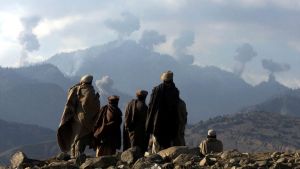Best Laid Plans: Council President on Afghanistan

Council President Ivo Daalder, former US ambassador to NATO, shares his perspective.
The images from Afghanistan are truly heart breaking. After 20 years of investment—of lives, treasure, and relationships—it has come to this. Desperate Afghans lifting their babies over barbed-wired walls to avoid being trampled and to give them a chance for a better future outside of Afghanistan.
How We Got Here
The history of what went wrong and why will cover many future volumes (although there are already some good early drafts to peruse). I spent four years deeply involved in US and NATO policy towards Afghanistan—a US Ambassador to NATO from 2009 to 2013—a period when troops under NATO command numbered 150,000 and important progress for the average Afghan was made. But it has long been clear to me that the effort we had embarked upon was very likely to fail. In my first visit to Afghanistan in 2009, I met a Dutch commander in Uruzgan province who was about to depart after a year of deployment in the south of Afghanistan. He told me that every day he’d been there he felt like he was walking through the Old Testament, both because of the beauty of the country and its people and because of the internecine fighting that had characterized the place for so long.
The image stuck with me during all my subsequent visits to Afghanistan while I was at NATO. This country is profoundly different from any of the nations that sent thousands of soldiers and millions of dollars, all in an effort to give the Afghan people a better, more hopeful future. These efforts, to be sure, had a profound impact on the lives of many—the millions of girls that could go to school and get an education, healthcare that helped reduce the infant mortality rate, new businesses that provided an income for growing families, and so much more.
And, yet, despite these and other improvements in the lives of Afghans, it was always clear that any prospect for real and sustaining change in Afghanistan would take a commitment and investment that few countries were willing to provide. Perhaps, with an indefinite commitment to provide security and aid and a willingness to stay as long as necessary for real success to take root, real change might have been possible. But given all the other priorities, no one thought this kind of commitment and investment was sustainable. Instead, what was on offer was the hope that with just one more year, things would finally turn around. That is how we ultimately stayed in Afghanistan for 20 years.
Best Laid Plans
President Biden has long believed the prevailing strategy in Afghanistan was profoundly mistaken. His was a lonely voice opposing a move to a counter-insurgency strategy and the accompanying troop surge during the debates about US policy towards Afghanistan in 2009, some of which I attended. He thought the Afghan government was totally corrupt and that the imposition of a centralized governing structure on a tribal society like Afghanistan was bound to fail. It should therefore have surprised no one that 12 years after losing the debate as vice president, a president Biden would opt to end US engagement.
We can debate the wisdom of Biden’s decision (and history, no doubt, will have its own verdict). But I, for one, don’t fault him on it, given the cards he held on January 20, 2021. Our policy had failed to produce a strong, viable government. Corruption wasn’t just rife; it was a way of life. The Taliban were waiting for us to leave, as the Trump administration had promised to do by May 2021. Reversing course wouldn’t just mean staying a while longer; it would mean building up significant forces to take on a reconstituted Taliban, now at its strongest since at least 2001.
But we can fault Biden on the execution. Knowing how corrupt, weak, and ineffective the Afghan government was, it made no sense to rely on that very government to enable the management of evacuating more than 100,000 people—from the many Western citizens who would have to leave once the Taliban took control to all those Afghans who had helped us during 20 years of operations. Rather than building down the military presence and leaving the evacuation of civilians in the hands of an Afghan government that was bound to collapse, sooner or later, it would have been much wiser to have built up the military presence in Kabul, keep Bagram airbase open, and help in the evacuation while we still dominated the ground and air.
When it came to withdrawing from Afghanistan, the US government planned for the best rather than for the worst—with the tragic consequences we’re now all seeing. The reasons and responsibility for this massive planning failure will have to be investigated closely. For now, however, the focus must be on getting people out, safely and quickly. That likely will require deploying more troops than are currently in country—including, perhaps, in places outside Kabul.
It is still too early to know the full extent of the damage the latest turn of events in Afghanistan will inflict—on Afghanistan, on the region, and on the United States and its allies who devoted so much for so long only to see it end in this deeply damaging way.
What we do know for certain is that the people of Afghanistan, who have already suffered through so much for so long, will unfortunately be made to suffer still more in the months and years to come.
A truly sad prospect, indeed.
Background from the Council
Afghanistan has been part of the Council’s work and focus for many years, starting in the late 1970s, following the Soviet invasion of Afghanistan, as you’ll soon be able to read about in Richard Longworth’s book on the history of the Council. We will continue to devote ample time and attention to the issue.
- In a special World Review episode, I talk with Steve Erlanger of the New York Times, Carla Anne Robbins of the Council on Foreign Relations, and Bobby Ghosh of Bloomberg Opinion about the fallout from Afghanistan.
- On September 8, former US Ambassador to NATO Douglas Lute, journalist and author Elliot Ackerman, and US defense policy expert Nora Bensahel will join Council Senior Fellow Elizabeth Shackleford for a conversation on the legacy of America’s longest war
- Several media outlets have referenced an early finding we shared from our 2021 Chicago Council Survey that 70 percent of Americans support the decision to withdraw US troops from Afghanistan by September 11. The poll, conducted in July, found support spanned partisan affiliations, though larger majorities of Democrats (77%) and Independents (73%) than Republicans (56%) agreed.
- I and several of our experts have been speaking with media or writing on Afghanistan. On a special Afghanistan page of our website, you can find the activities listed above and additional content from the Council, including last week’s episode of our Deep Dish podcast, which explores Pakistan’s Taliban gamble.


Related Content
 US Foreign Policy
US Foreign Policy
Winning hearts and minds doesn't defeat insurgent groups, author Jacqueline Hazelton argues. So why does the United States still rely on counterinsurgency?
 US Foreign Policy
US Foreign Policy
"You cannot build good foreign policy on dishonesty. But we keep trying to because no one pays for it," writes Elizabeth Shackelford.
 Public Opinion
Public Opinion
Polling conducted in July for the 2021 Chicago Council Survey found seven out of ten Americans supported the withdrawal of US combat forces from Afghanistan by September 11.
